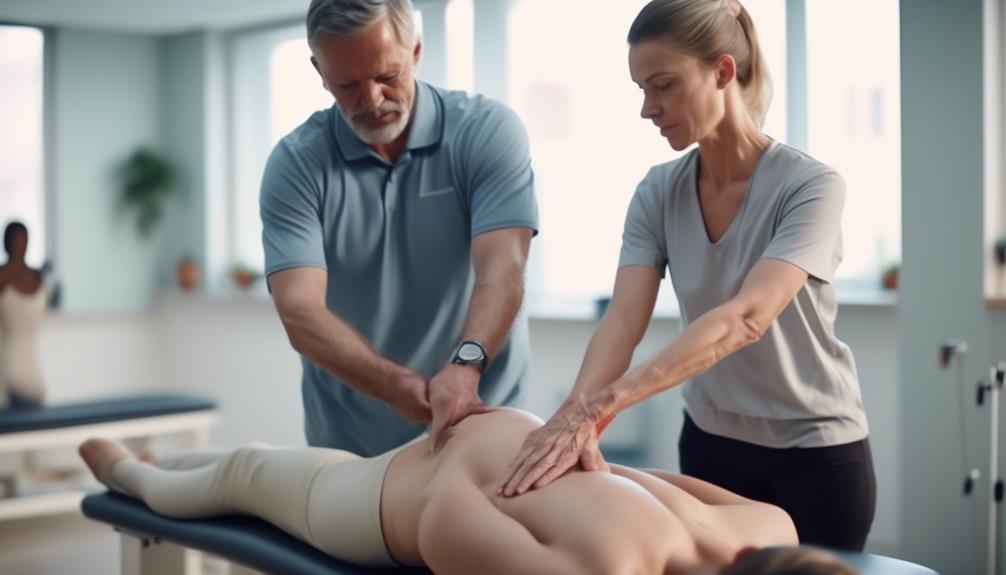Mastering Chiropractic Techniques for Improved Spinal Health
The spinal column, the structural core of our body, has a profound impact on our overall health. When it comes to maintaining or restoring spinal well-being, individuals often seek chiropractic care, a field dedicated to treating spinal disorders without surgery. Whether it’s relief from persistent back pain, recovering from an injury, or wanting to improve posture and flexibility, the practice of chiropractic offers a way to enhance quality of life through specialized techniques.
Chiropractors can be compared to sculptors of the human body, meticulously working to bring balance and harmony to the intricate structures of the spine. With their skilled hands, they combine science and artistry, using methods such as spinal adjustments, therapeutic massage, and carefully tailored therapies to address the discomfort and lack of mobility that affect so many.
For those navigating the complexities of spinal health, the promise of relief and improved functionality is within reach. As we delve into the intricacies of chiropractic care, be assured that the journey ahead will reveal the transformative potential of these techniques, inviting you to experience the profound benefits they can provide.
Main Points
- Chiropractic care offers a variety of techniques, such as the diversified technique and spinal manipulation, to realign joints and bones and relieve pain.
- Chiropractic massages and flexion distraction technique can improve mobility, stimulate healing, and target specific issues like lower back pain and joint dysfunction.
- Cold/hot pack chiropractic therapy can reduce inflammation and promote relaxation, complementing other chiropractic techniques.
- Chiropractic care focuses on promoting long-term spinal health, enhancing overall quality of life, and preventing injury recurrence.
Understanding Chiropractic Techniques
What are the common chiropractic techniques used for promoting spinal health?
Understanding spinal health is fundamental to appreciate the various chiropractic techniques chiropractors use.
The diversified technique, a popular hands-on approach, realigns joints and bones through targeted pressure. This method is often employed in spinal adjustments, a cornerstone of chiropractic treatment aimed at restoring alignment and function.
Another widely used method is spinal manipulation, which manually realigns the spine and other joints to alleviate pain and enhance mobility. This technique can be instrumental in managing chronic pain and improving overall spinal health.
Chiropractic massages focus on manipulating soft tissues through targeted pressure to mitigate discomfort and stimulate healing. These techniques are a testament to the versatility in mastering chiropractic techniques.
The flexion distraction technique gently stretches and flexes the spine to reduce nerve pressure and promote recovery. This is particularly beneficial for those with herniated discs or scoliosis.
Lastly, the cold/hot pack chiropractic therapy applies cold or hot packs to reduce inflammation or promote increased blood flow. This method can significantly contribute to pain relief and improved flexibility, making it a vital part of comprehensive chiropractic treatment.
Spinal Health and Chiropractic Care
Spinal health is inherently connected to chiropractic care, a discipline devoted to the identification and management of mechanical issues within the musculoskeletal system, specifically the spine.
Different chiropractic methods, like Diversified, Spinal Manipulation, and Chiropractic Massage, aim to improve joint function, alleviate pain, and foster overall spinal health.
By adopting a comprehensive approach, chiropractic care not only provides immediate relief from discomfort but also contributes to the long-term well-being of the spine.
Understanding Chiropractic Care
Delving into the realm of chiropractic care, it is crucial to understand that this comprehensive approach to spinal health employs a range of techniques, each designed to promote injury recovery, enhance stability, alleviate pain, and contribute to overall well-being.
Mastering chiropractic techniques is fundamental to achieving optimal spinal alignment and functioning of the musculoskeletal system. Chiropractic adjustments are tailored to the patient’s unique needs and can range from gentle to more forceful approaches. Practitioners often employ various spinal adjustment techniques explained in detail during consultations, ensuring patients understand the rationale and benefits of each method. By combining traditional practices with modern approaches, chiropractors can effectively address diverse conditions, promoting both immediate relief and long-term wellness. This personalized approach not only enhances physical health but also fosters a trusting relationship between the patient and the practitioner.
Understanding chiropractic care involves appreciating its holistic perspective, focusing not only on treating symptoms but also on promoting long-term spinal health. Its benefits extend beyond pain relief to include improved mobility, prevention of injury recurrence, and an enhanced quality of life.
Benefits of Spinal Health
Regularly employing chiropractic techniques can yield significant benefits to spinal health, including pain relief, enhanced mobility, and improved overall wellness. The Benefits of Chiropractic treatment are numerous, providing much-needed relief to individuals suffering from spinal conditions.
- Chiropractic care stimulates the natural production of pain-relieving hormones, offering a non-invasive option for pain relief.
- Spinal Manipulation: High-Velocity Low-Amplitude techniques enhance blood flow, promoting faster healing.
- Chiropractic joint adjustments restore stability, reducing the risk of future injuries.
- Techniques such as massage help alleviate muscle tightness, contributing to overall well-being.
- Chiropractic’s holistic approach promotes natural healing processes by focusing on proper musculoskeletal alignment.
Embracing chiropractic techniques can lead to a healthier spine, improved mobility, and a better quality of life. Incorporating chiropractic techniques for better posture not only alleviates discomfort but also enhances overall body alignment. Regular sessions can help prevent future issues, allowing individuals to engage more fully in their daily activities. By prioritizing spinal health, one can enjoy increased energy levels and greater overall well-being.
The Diversified Technique Explained
Renowned for its high effectiveness in promoting spinal health, the Diversified Technique is a widely adopted chiropractic adjustment method that uses targeted pressure to realign joints and bones, thus improving range of motion and mobility. This hands-on approach allows a chiropractor to manually adjust the back and neck, ensuring proper alignment.
The diversified technique is frequently used for musculoskeletal injuries, aiming to relieve pain, reduce inflammation, and improve joint function. A sudden force is applied to the joint, often resulting in an audible sound, which indicates the release of gas and fluid to lubricate joint surfaces and restore movement.
| Diversified Technique | Benefit |
|---|---|
| Spinal Adjustment | Enhances range of motion and mobility |
| Use of hands | Ensures proper alignment of back and neck |
| Relieves Pain | Reduces inflammation and enhances joint function |
| Rapid Force Application | Facilitates the release of gas and fluid, restoring movement |
The diversified technique is a chiropractor’s preferred method, often complemented by additional procedures such as soft tissue techniques and exercise recommendations. This approach promotes healing and reduces the formation of scar tissue, providing a comprehensive approach to spinal health.
Benefits of Spinal Manipulation:
- Improved spinal alignment and posture.
- Reduction in back and neck pain.
- Increased range of motion in the spine.
- Enhanced joint mobility.
- Decreased muscle tension and stiffness.
- Improved overall physical function.
- Relief from headaches and migraines.
- Enhanced nervous system function.
- Improved blood circulation.
- Boosted immune system function.
Please note that this translation is provided in British English.
Whilst the Diversified Technique holds a prominent place in the chiropractic toolbox, another critical aspect of chiropractic care that offers significant benefits is spinal manipulation. Mastering chiropractic techniques, particularly spinal manipulation, can lead to enhanced spinal health and overall well-being.
The benefits of spinal manipulation are manifold. Here are some key advantages:
- It stimulates the production of natural pain-relieving hormones, thus reducing pain.
- It promotes quicker healing by enhancing blood flow to the injured area, providing necessary nutrients and immune cells.
- Chiropractic manipulation can improve stability by adjusting and realigning joints, reducing the risk of future injuries.
- Specific techniques, like massage and ultrasound therapy, can ease muscle spasms and promote relaxation.
- Chiropractic therapy offers a holistic approach, focusing on restoring musculoskeletal alignment and promoting natural healing processes.
In essence, spinal manipulation is a crucial component of chiropractic care. Its benefits extend beyond immediate pain relief, offering long-term solutions for improved stability and enhanced spinal health.
Whether you’re a practitioner looking to refine your skills or a patient seeking relief, understanding and appreciating these benefits can greatly contribute to optimised therapeutic outcomes.
Role of Chiropractic Massage:
Chiropractic massage plays a significant role in promoting overall health and well-being. It is a form of therapeutic treatment that focuses on the manipulation of the spine and musculoskeletal system to alleviate pain, improve mobility, and enhance physical function.
The primary goal of chiropractic massage is to restore the proper alignment of the spine, which is believed to be essential for the optimal functioning of the nervous system. By manually adjusting the spine, chiropractors aim to alleviate pressure on the nerves and promote the body’s natural ability to heal itself.
Chiropractic massage can help with various conditions, including back pain, neck pain, headaches, and joint problems. It is commonly used to treat sports injuries and musculoskeletal disorders.
An integral component of comprehensive chiropractic care, chiropractic massage, applies targeted pressure on soft tissues to alleviate pain, promote healing, and enhance overall spinal health. This manual therapy technique is employed by chiropractors to stimulate natural healing processes and contribute to the overall well-being of patients dealing with specific health issues.
Chiropractic massage is a highly specialised technique. It involves the use of specific, hands-on manipulations that improve blood circulation and reduce scar tissue formation. This aids in providing relief from muscle tightness, reducing pain and promoting relaxation.
Chiropractors employ this therapy as part of a comprehensive treatment plan designed to address individual patient needs. The goal is to provide a holistic approach to spinal health that goes beyond mere symptom management. The use of chiropractic massage in conjunction with other techniques offers a synergistic effect, enhancing the overall effectiveness of the treatment plan.
Flexion Distraction Technique: An Overview
Flexion Distraction Technique: An Overview
The Flexion Distraction Technique is a fundamental method in chiropractic care. It provides a non-invasive approach to relieving spinal discomfort and improving overall spinal health. It entails a combination of gentle bending and stretching of the spine, specifically focusing on compressed nerves and facilitating healing in particular spinal conditions.
In the subsequent conversation, we will examine the comprehension of this technique, its various advantages, and the secure implementation methods in chiropractic treatment.
Understanding Flexion Distraction Technique
In the realm of chiropractic care, the Flexion Distraction Technique stands as a gentle, yet effective method designed to stretch and flex the spine, thereby reducing nerve pressure and promoting healing. This technique, often used by chiropractors, is a cornerstone in mastering chiropractic techniques for enhanced spinal health.
Understanding the Flexion Distraction Technique involves recognising its key features:
- It is a non-surgical, drug-free treatment option.
- The method targets lower back pain and joint dysfunction.
- It employs a specialised table for precise spinal mobilisation.
- The technique is particularly effective in treating disc injuries.
- Regular application can lead to improved posture and movement.
In essence, the Flexion Distraction Technique exemplifies how chiropractic care can offer non-invasive, effective solutions for spinal health issues.
Benefits of Flexion Distraction:
- Improved Spinal Alignment: Flexion distraction therapy helps to restore proper alignment of the spine, reducing pressure on the nerves and promoting overall spinal health.
- Pain Relief: This technique has been found to be effective in providing relief from various types of back and neck pain, including disc herniation, sciatica, and spinal stenosis.
- Increased Joint Mobility: Flexion distraction therapy helps to gently mobilize the spinal joints, improving flexibility and range of motion.
- Decompression of Spinal Discs: By applying gentle traction and flexion to the spine, this therapy helps to decompress the spinal discs, reducing disc bulges and promoting healing.
- Improved Circulation: The pumping
Numerous advantages are associated with the Flexion Distraction Technique, a non-invasive chiropractic method primarily utilised for alleviating nerve pressure and improving spinal stability.
This widely used chiropractic technique gently stretches and flexes the spine using a specialised table, particularly benefiting the lumbar spine or lower back.
It is an effective tool for easing muscle spasms and reducing pain, making adjustments to the spine more comfortable for the patient.
This technique addresses specific spinal and joint issues, promoting overall health in the back region. Especially suitable for treating conditions like lumbar disc syndrome with radiculopathy, it fosters a holistic approach to spinal health.
In essence, the Flexion Distraction Technique is a potent method for enhancing spinal stability and health.
Implementing Flexion Distraction Safely
With its focus on gentle spinal manipulation, the Flexion Distraction Technique requires a high level of expertise and specific training to ensure its safe and effective implementation. It is a chiropractic spinal technique, utilised by practitioners who are versed in a variety of techniques to meet the specific needs of their patients.
- Flexion Distraction Technique is a process that helps to gently stretch and flex the spine, reducing nerve pressure and promoting healing.
- This technique is particularly suitable for addressing spinal disc issues, back and leg pain.
- A specialised table is typically used in this technique, ensuring safety and effectiveness.
- The technique is a gentle, non-invasive approach to addressing spinal health issues.
- Implementing this technique requires 78 hours of specialised training and expertise to ensure safety and effectiveness.
Cold/Hot Pack Chiropractic Therapy
Harnessing the power of temperature, Cold/Hot Pack Chiropractic Therapy employs the strategic application of cold or hot packs to alleviate inflammation or enhance blood circulation, thereby relieving pain and enhancing flexibility. This technique used by chiropractors plays a crucial role in managing both acute injuries and chronic pain.
Cold packs are primarily used to reduce inflammation and swelling, significant in the immediate stages of injury. On the other hand, hot packs are used to increase blood flow and promote muscular relaxation. This approach to pain can be instrumental in addressing muscle tightness and facilitating the body’s natural healing processes.
Furthermore, the alternating use of cold and hot packs can provide a contrast therapy effect, aiding in pain relief and tissue healing. This is particularly beneficial in treating patients with recurring or persistent conditions.
Cold/Hot Pack Chiropractic Therapy complements other chiropractic techniques and adjunctive therapies, allowing for a comprehensive approach to injury recovery. In this regard, the treatment is tailored to meet the needs of each patient, taking into account their specific condition and recovery goals. Thus, this therapy underlines the versatility and adaptability of chiropractic care.
Improving Spinal Health Through Rehabilitation Exercises
Building on the foundation of chiropractic care, rehabilitation exercises play a crucial role in enhancing spinal health, focusing on improving strength, flexibility, and stability. These targeted exercises, often integrated with Low-Force or Gentle Chiropractic treatments, are essential for both managing pain and restoring function in specific joints.
To explain further:
- Rehabilitation exercises are specifically designed to improve the range of motion in the spine and surrounding muscles, aiding in recovery and preventing future injuries.
- These exercises promote proper alignment of the spine, which is vital for reducing pain and enhancing overall health.
- Tailored to individual needs, these exercises may include stretching, core strengthening, and movements addressing specific spinal issues.
- Under the guidance of a chiropractor, these exercises can complement chiropractic treatments, including Mobilization (Low-Force or Gentle Chiropractic).
- They help restore posture and correct imbalances, contributing significantly to spinal health.
Frequently Asked Questions
What is the most effective chiropractic technique?
The effectiveness of a chiropractic technique varies, influenced by patient satisfaction, technique selection, training requirements, technique evolution, safety measures, and outcome measurement. Thus, the ‘most effective’ technique is often patient-specific and situation-dependent.
What Is the New Technique of Chiropractic?
The latest chiropractic technique, reflecting new adjustments and technique evolution, is Torque Release Technique. Its effectiveness, safety, and positive patient response are notable, but it requires specific training, promising exciting future prospects in spinal health.
What is the Gonstead Technique?
The Gonstead technique, based in chiropractic history, precisely focuses on spinal misalignments through thorough assessment. Despite common misunderstandings, patients report positive experiences, crediting the technique’s development and minimal side effects to improved spinal health.
What are two methods a chiropractor would use to improve a patient’s health in a body system?
Chiropractors frequently use the Diversified Technique and Spinal Manipulation Technique to improve a patient’s health. These methods realign joints and bones, relieve pain, decrease inflammation, and enhance mobility, especially for musculoskeletal injuries.










